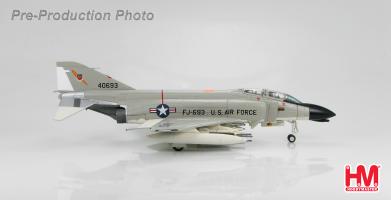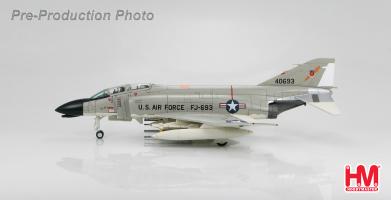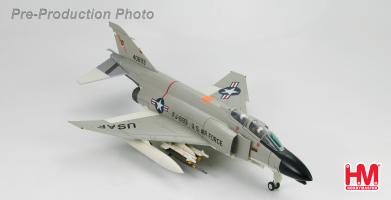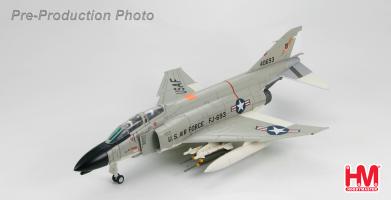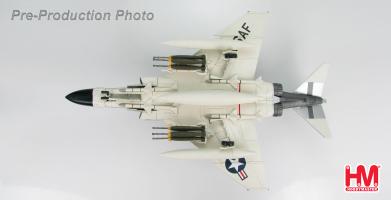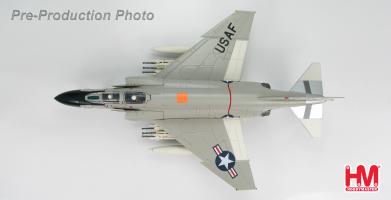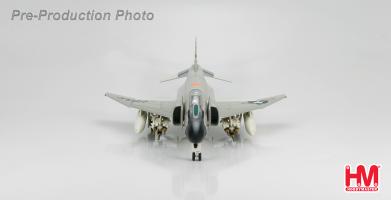Hobby Master Archive
Air Power Jets 1/72
F-4
McDonnell Douglas F-4C 64-0693 FJ-693, 45th TFS, Ubon, Thailand, July 1965 First USAF MIG Killer
The first of 583 F-4C ordered by the USAF began delivery in late 1963. They basically were F- 4Bs that had been refit for ground operations. The F-4C arrived in Southeast Asia in early 1965 and by 1966 equipped 7 squadrons in Vietnam and 3 in Thailand. The early F-4Cs lacked guns and relied totally on missiles but it wasn’t long before the addition of SUU-16A gun pods with M- 61AI-20-mm guns were put to use to compensate for the lack of internal guns. The addition of these gun pods gave the pilot gun fire but degraded the performance of the aircraft. The first F- 4Cs suffered from many defects such as wing tanks that would spring leaks and require resealing after every flight. Many had cracked ribs on outer wing panels. It wasn’t too long before the F-4D made an appearance.
On July 10, 1965 F-4C 64-0693 from the 45th TFS 2nd AD crewed by Capt. K.E. Holcombe and Capt. A.C. Clark using the callsign “Mink 03” shot down a Mig-17 using AIM-98 missiles. The normal procedure was for a flight of F-4s to fly ahead of a flight of F-105s and clear they way. The MiG-17s would wait for the second flight comprised of the F-105s before they would attack. The Vietnamese People’s Air Force knew that by waiting the escorting F-4s would be low on fuel and couldn’t stay to protect the F-105s. On July 10, 1965 things were different; there were no F- 105s in either of the two flights. Four F-4Cs with call signs Mink 01 through 04 departed 20 minutes after the first flight and flew at 20,000 feet and mach .85 to simulate the characteristics of a flight of F-105s. Once the Minks arrived at the target area VPAF Mig-17s arose to the occasion only to find F-4Cs instead of the usual F-105s. After being drawn into a turning fight Mink 03 dived and climbed and managed to get behind the MiG-17. Mink 03 fired an AIM-9B but missed due to a radar malfunction so they immediately fired 3 more. Two of the missiles were fired without lock-on but exploded close enough to reduce the MiG-17 to a fire ball. This action made Capt. K.E. Holcombe and Capt. A.C. Clark the first crew to shoot down a MiG-17. On July 30, 1967 F-4C 64-0693 and crew now assigned to the 559th TFS were lost over the southern panhandle of North Vietnam.
Specification of the F-4C Manufacturer: McDonnell-Douglas Role - Fighter Performance Engines - (2) General Electric J79-GE-15 turbojets, 10,900 lb.s.t dry, 17,000 lb.s.t. with afterburner Maximum Speed - 1,433 mph @ 48,000 ft, 826 mph at sea level Initial Climb Rate - 40,550 fpm Service Ceiling - 56,100 ft Combat Ceiling - 55,600 ft Combat Range - 538 miles Maximum Range - 1,926 miles with maximum external fuel Weights Empty - 28,496 lbs Gross - 51,441 lbs Combat Weight - 38,352 lbs Maximum Take-Off Weight - 58,000 lbs Dimensions Wingspan 38 ft 5 ins Wing Area - 530 sq ft Length - 58 ft 3 3/4 ins Height - 16 ft 3 ins Fuel Maximum Internal - 1,986 US gallons (1,343 gallons in fuselage, 630 gallons in wings) Maximum External - 600 US gallons in centerline tank underneath the fuselage and 740 US gallons in (2) under-wing tanks / total fuel to 3,313 US gallons Armament (4) AIM-7D or -7E Sparrow semi active radar homing missiles in under-fuselage recesses Inner pylons could each accommodate (2) AIM-9B/D Sidewinder infrared homing missiles Ground Attack Mode - able to carry up to 16,000 pounds of ordnance on centerline pylon underneath the fuselage Plus (4) under-wing hard-points
Hobby Master 1/72 Air Power Series HA1930 McDonnell Douglas F- 4C “64-0693” FJ-693, 45th TFS, Ubon, Thailand, July 1965 “First USAF MIG Killer”
True 1/72 scale Professionally painted Great attention to detail All markings are Tampoed (pad applied)
Option to display the model on a stand that is provided Model can be shown with the landing gear in the down or up positions Canopies can be displayed open or closed Crew figures Extremely heavy metal with a minimum of plastic Highly collectable
| Added to archive | 2015-11-19 |
| Last modified | 2015-11-19 |
| Leaflet | 2012-05-01 May 2012 |
